HER MAJESTY, THE QUEEN’S “SANDRINGHAM LABRADORS” (UK)
The Queen’s gundogs are respected throughout the Labrador world, especially when it comes to highly skilled gun dogs I have to admit, I’ve always liked that the Queen loves dogs and horses–as do I!!! But when I found out she bred LABRADORS I had to research it–and how FUN that research is for those interested in the history of the English/British/UK Labrador.
(CLICK ON ANY OF THE BELOW PICTURES TO ENLARGE THEM TO SEE THE ORIGINAL CAPTIONS!)
THE QUEEN’S GUNDOGS
Miss Elizabeth Walton, of The Field magazine says, “Norfolk was, as the natives say, raw cold on a January day in 2012. HM The Queen was picking-up behind a line of guns on the Sandringham estate, working her beloved cocker spaniels with consummate skill. In the game-shooting calendar the scene is familiar, even unremarkable. David Clark, MVO, Sandringham’s headkeeper, says, “You see a lady wearing a headscarf with a load of dogs around her, and in a field of sporting people you wouldn’t pick Her Majesty out.” A vivid image; for once, truly a private life. And as for the dogs, none of them knows its handler has been head of state for over six decades.”
Ms. Walton goes on to say, “Like duty, dogs are a constant in The Queen’s quotidian existence. British gundogs are the best in the world and Her Majesty has been their keenest supporter from childhood when she commandeered any available dog to find birds at Balmoral, alert to the vagaries of scent and wind. A Pembrokeshire corgi might be pressed into service, the breed’s good nose and small stature ideal for locating fallen grouse in deep heather, although an actual retrieve could prove problematic.
The Royal Family have long been dog fanciers. Under Queen Alexandra’s control, the Sandringham kennels sometimes housed a hundred dogs, the breeds including borzois, chow chows and pugs, and the Sandringham strain of labrador retriever was founded in 1911. Our own Queen enjoys a striking affinity with dogs and horses. She understands her animals and this instinct allows her to read their behaviour. “The great thing is,” says Clark, “animals understand her as well. That’s why she’s an amazing dog handler.”
Ms Walton further notes, “Paradoxically, instinct is learnt or accreted through experience. King George VI’s passion for game-shooting alerted his daughter to a well-trained gundog’s indispensable contribution. The King, however, declined actively to encourage the princess to work gundogs in the shooting field and it fell to Jack Curtis, Her Majesty’s original gundog trainer, to nudge her towards handling a labrador.
With black labradors Snare and Sabre as her first dogs, The Queen’s enthusiasm gathered pace until an ambition to improve Sandringham’s dogs, including those of her keepers, hardened into a determination that they should win field trials, the competitive test for working retrievers. Trial champions would be good sires and dams for the development of future lines. Back then, showing and trialling were not in sharp divergence, and Sandringham dogs would find fame for a winning combination of good looks and brains.”
George Meldrum’s Rumbleton Kennels in Fife enjoyed the highest reputation, and Her Majesty had seen Meldrum’s son Bill running dogs in the Retriever Championship, which he won in 1963 with field-trial champion Glenfarg Skid. When Curtis retired, the young Meldrum soon found himself at Sandringham, pondering the pros and cons of an appointment as the next trainer of The Queen’s gundogs. Annie, Meldrum’s wife, remembers Lady Hill-Wood, a renowned labrador trainer and judge, making the first approach. She cajoled the reluctant pair, rooted in Scotland, into making a preliminary visit to Sandringham to see The Queen’s gundogs.
THE QUEEN’S GUNDOGS: HER MAJESTY’S PERSONAL DOGS
Mr. Walton adds, “Bill Meldrum, LVO, RVM is tall and direct, his wisdom buttressed by an unyielding Scots accent. His career in charge of the Sandringham kennels would eventually span 41 years; 20 spent training The Queen’s gundogs full-time and the remainder as the Sandringham headkeeper. When he took over from Curtis in 1964, the kennels housed 37, with Wren joining Snare and Sabre as The Queen’s personal dogs. While each member of this trio was a good hunting dog, ideal for picking-up, Her Majesty’s strategy for breeding centred on getting a dog that could be handled at 200yd out.
In the event, Her Majesty’s very first tactical decision to this end would result in a bitch named Sherry that was dear to her heart, and dear to Meldrum as well. “Sherry was by Skid,” he says. “She was bred by Bill Davidson, an electrician in the coalmines up in Durham. I would say Sherry was The Queen’s favourite. Sherry was a star.” The black labrador was everything The Queen had hoped for: a dog with flair and initiative that Meldrum could make up into a field-trial champion to grace the Sandringham kennels.
The season was hectic. “We had about 10 weeks at Balmoral in those days,” Meldrum recollects. Strength in depth was required; a pantechnicon, two drivers and a kennel boy rushed The Queen’s gundogs through the night from the Sandringham kennels. “The average bag would be over 200 brace a day, and as we were shooting six days a week to start with, we needed about 35 dogs to work.” They worked one day on, one day off – “bar a field-trial dog like Sydney. He would go out maybe three or four times a week because he would get a long retrieve – he wouldn’t be hunting.”
When Meldrum had made up seven Sandringham field-trial champions, trialling was phased out – including the invitation events held regularly on Dersingham Bog at Sandringham where The Queen herself could judge and compete (and once win) out of the public eye. Commercial breeding also ceased, and the 22 labradors and cocker spaniels currently housed in the cacophonous kennels are now in the sedulous care of Alan Goodship, RVM. The annual trip to Balmoral aside, the peripatetic regime is over. Goodship grins, “Mr Meldrum was never at home; I don’t travel. I’m a Norfolk boy. My country stops at Kings Lynn.”
THE QUEEN’S GUNDOGS: CONTINUTY OF CHARACTERS
Ms Walton concludes: “The fourth generation of his family to work on the estate, Goodship came under Meldrum’s tutelage as a 12-year-old schoolboy who puppy-walked. That was 33 years ago, and the continuity of characters, both human and canine, lends the kennels a powerful atmosphere. “Mr Meldrum taught me standards,” says Goodship. “He was fair; you never did anything he didn’t do. He and Mrs Meldrum were both very kind to me.” Any kennels demands attention seven days a week and Goodship relies on the assistance of his wife, Lynda. In the Goodships, The Queen has found fellow devotees of the corgi.”
“With two young dogs scheduled for a training session, Goodship parks up beside a 1977 Jubilee Wood in Sandringham Park and a barn owl takes its ghostly leave. Around Laycock’s Pond the greylag geese are quarrelsome. “The pinks came over last night; they’ll soon be going away,” says Goodship, completely in tune with this estate which makes an exceptional contribution to conservation. The Sawyer is a yellow labrador from the Ken Hill estate in Norfolk and named Fudge by The Queen. Raveningham Gilbert, a cocker spaniel she named Bertie, was a gift from Sir Nicholas Bacon. Wild-eyed and boisterous, Bertie is in the line of Flash, a recently lost royal veteran. “Bertie was sick as a puppy, and thoroughly spoilt,” says his trainer to explain an exuberant greeting. “But he can find game.” Sure enough, given the office, Bertie flies at the dummy as if to a magnet. His hands clapped to simulate a gunshot, Goodship urges Fudge to “Get over!” a fence. Her belly touches it first time. But at each successive attempt, her retrieves growing longer, this generous and talented dog wings it. “We’ll have some pups out of her. She’s a lovely little dog,” says Goodship. “When she hunts, she works so hard.” Her Majesty has presented a full sister of Fudge, also trained at Sandringham with The Queen’s gundogs, to the Royal Canadian Mounted Police.”
It seems that dogs and dog people, sincere and unaffected, have afforded HM The Queen the quiet joy of countryside values far from the punishing rigours of a life of service. If she derives as much pleasure from the royal dogs as Meldrum and Goodship suggest, then we owe them a debt of gratitude. Long may Her Majesty enjoy their company.
Portions of this blog originated in a UK article from the magazine, THE FIELD. Article by Ms. Elizabeth Walton. April, 2016.
TO FIND THE KENNEL OF QUEEN ELIZABETH, LOOK UP SPRUCEDELL LABRADORS
***IF YOU SEE THIS ARTICLE ON THE WEBSITE “PETSYNSE” LET US KNOW, AS THEY ARE ENGAGING IN COPYRIGHT ENFRINGEMENT AND ARE COPYING ALL THE BLOGS ON HERE ONTO THEIR SITE AND TAKING CREDIT****
All Blogs and information on website are (C) Copywritten. 2021, by Donna Stanley, Endless Mt. Labradors, and is not for use unless by permission only by Donna Stanley.

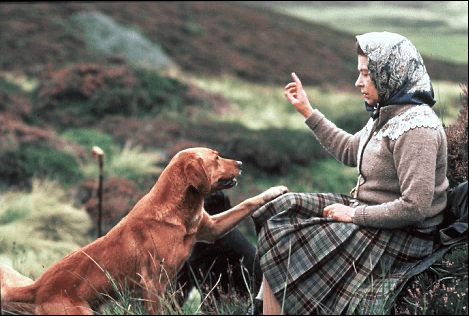
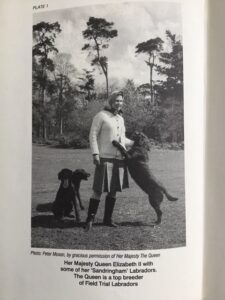
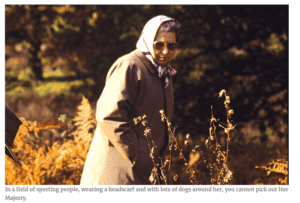
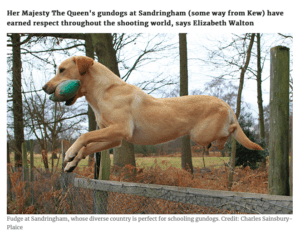
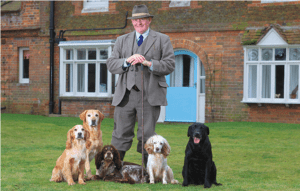

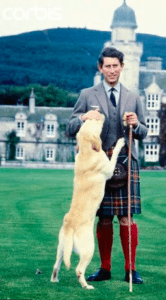
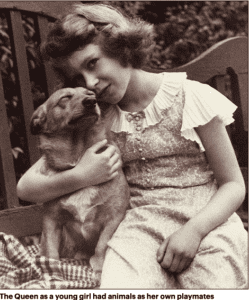
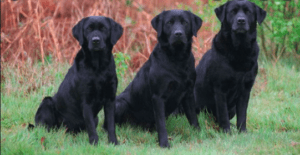
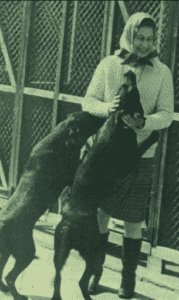
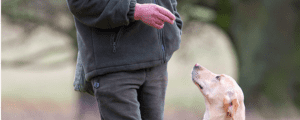
1201 Comments